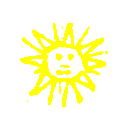Alisa og Claus Clausen on fri 9 feb 01
Tony Hansen matt cone 6 ox. with colorants.
The following tests were all done with the same base on white, mid range =
stoneware, fired to 1220c, oxidation.
Receipe
27 Wollastonite
36 Frit 3134 (subbed with local Frit)
35 EPK
5 Flint
1.
just base
clear base, shiny where thickest, semi gloss where thinnest.
2.
10% ochre =20
yielded a dark tan to greenish gloss.
Ran off the test tile.
3.
6% Zinc oxide plus 1% Cobalt oxide.
medium blue gloss, pinholed where thickest,
very fluid but not did not run off tile.
4.
1% Cobalt oxide plus 3% Copper carb.
Slightly darker and more intense blue than above. =20
Pinholed and very fluid.
5.
2% Cobalt oxide plus 4% Rutile.
Dark blue to black gloss where thickest,=20
pinholed and very fluid to
medium blue with greenish nuance semi matt where thinner on rims,
brown speckling. Stable where matter and thinner.
6.
1%cobalt oxide, 2% RIO plus 4% Rutile.
Tenmoku like glaze, covering and stable.
Shiny black where thickest, satin matt brown where thinner.
Smooth surface.
7.
1 Cobalt oxide pluts 5 Rutile
Stable tan matt with light green streaking.
Light blue where thickest. Smooth surface.
8. =20
8 RIO plus 1 Cobalt oxide
Stable matt brown to glossy black with rust speckling where thickest.
Smooth Smoth surface. Similar but slightly glossierthan nr. 6 test.
9. =20
12 RIO
Stable around edges brown, rust to black semi matt glaze. Where thicker =
in middle of test tile, the glaze shows a lot of movement and is =
lightest in color, with a lot of rust streaking.
3% Copper carb.
Light green, celedon look gloss, pinholed and runny.
Nrs. 5, 6, 7 and 8 were the most succesful as far as stability and =
surface texture.
This base seem sto do better with with RIO than cobalt as far as =
stability and smoothness of surface.
Best regards,
Alisa in Denmark
| |
|

 search
search